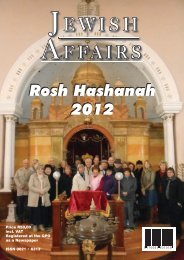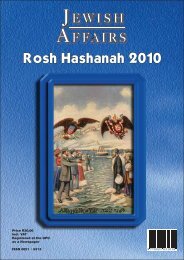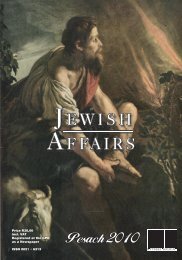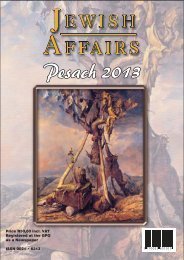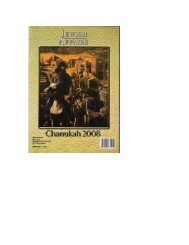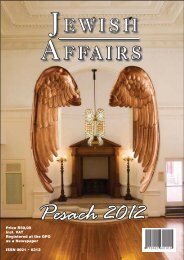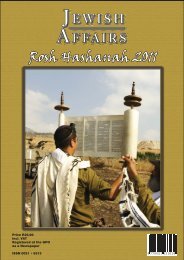Rosh Hashanah 2009 - South African Jewish Board of Deputies
Rosh Hashanah 2009 - South African Jewish Board of Deputies
Rosh Hashanah 2009 - South African Jewish Board of Deputies
- No tags were found...
Create successful ePaper yourself
Turn your PDF publications into a flip-book with our unique Google optimized e-Paper software.
JEWISH AFFAIRS ROSH HASHANAH <strong>2009</strong>orphans grew up without education. This could thenexplain the unusual language and lack <strong>of</strong> education<strong>of</strong> the Hottentots. He finally demolishes Kolbe bysaying:Almost all facts known about Hottentots have upto the present been taken from Kolbe, and Kolbewho in his time lived as long at the Cape as I didafterwards, namely eight years, describes thispeople to us as wearing long moustaches andwhiskers like half-shaven Jews. It is impossiblethat he should never have seen Hottentots duringhis eight years’ stay, but to judge from thisdescription <strong>of</strong> his, he cannot have seen any, forthere are rarely any traces on their faces <strong>of</strong> thewoolly hair <strong>of</strong> their heads, and as far as one cansee their naked bodies and those <strong>of</strong> their women,not a single hair can be noticed. (I can vouch forthe reliability <strong>of</strong> my account.)Unlike Georg Meister, Johannes de Grevenbroek,Pierre Kolbe or Gysbert Hammy, Otto Mentzel’sstatements imply a basic knowledge <strong>of</strong> <strong>Jewish</strong> beliefsand practices. Where would he have acquired suchknowledge? Mentzel grew up in a cultured andintellectually stimulating home. His father was aPrussian H<strong>of</strong>rat and Court physician, whose extensivelibrary was later included in the Royal PrussianLibrary. It is possible that he met Jews in his parent’shome or read books about Jews in his father’s library.Neustädtel in Lower Silesia, where he became Chief<strong>of</strong> Police, is now known as Nowe Miasteczko inPoland, and there in his position and with his openmindedcuriosity about people, he would have comeacross many Jews, on both sides <strong>of</strong> the law. Heprobably learned about them, as he had previouslylearned about the Hottentots, by talking to them andobserving their customs.The truth is now out. The Hottentots have comefrom Africa. So have the Jews. Indeed, so have theancestors <strong>of</strong> the Dutch and German travellers.Grevenbroek, Meister and Kolbe were right so far asthat goes and Mentzel wrong. The Hottentots and theJews are related, but then so are Grevenbroek, Meisterand Kolbe. So, in fact, are all human beings. We allcarry within our genes the same mitochondrial DNAthat can be traced back to a single woman living inAfrica over 150 000 years ago. 34 Despite beliefs inracial superiority, 80% <strong>of</strong> modern Europeans aredescended from the old <strong>African</strong> hunter-gatherers. Somuch for their much vaunted cultural superiority!The writer <strong>of</strong> this article had her DNA tested. Hermitochondrial DNA shows that her ancestors leftAfrica, between 60 000 - 80 000 years ago, findinga foothold during the ice age in Asia, Australia andparts <strong>of</strong> Europe. It is the mitochondrial DNAassociated with Eurasian groups and is shared withmany people living along the Mediterranean,including many Ashkenazim.To answer Willem Ten Rhyne <strong>of</strong> Deventer’squestion 400 years later: The KhoiSan did not springfrom Ham, with the exception <strong>of</strong> some Arabs <strong>of</strong> thestock <strong>of</strong> Shem who entered Africa later on. Ham andShem sprang from the KhoiSan and exited Africalater on.NOTES1 Basil Davidson, ‘<strong>African</strong> Kingdoms’, Great Ages <strong>of</strong> Man, AHistory <strong>of</strong> the World’s Cultures, 1967,172 Andrew Smith, ‘Different Facets <strong>of</strong> the Crystal: EarlyEuropean Images <strong>of</strong> the Khoikhoi at the Cape, <strong>South</strong> Africa’,In <strong>South</strong> <strong>African</strong> Archaeological Society Goodwin Series7,1993,9-103 William ten Rhyne <strong>of</strong> Deventer, ‘A Short Account Of TheCape <strong>of</strong> Good Hope and <strong>of</strong> the Hottentots who Inhabit thatRegion’, Schaffhausen, 1686 in The Early Cape Hottentotsdescribed in the writings <strong>of</strong> Olfert Dapper (1668), WillemTen Rhyne (1686) and Johannes Gulielmus de Grevenbroek(1695) Van Riebeeck Society, 1933, 934 Mbeki states that the quote was cited in: Africa: A Biography<strong>of</strong> the Continent, John Reader, Hamish Hamilton, London,1997.5 From The Natural History <strong>of</strong> Pliny The Elder, book 7http:/oaks.nvg.org/pliny.html. Smith op cit, 96 Stanley Casson, The Discovery <strong>of</strong> Man: The Story <strong>of</strong> theInquiry into Human Origin, 1940, 77-87 Originally so called by early travellers because <strong>of</strong> the sound<strong>of</strong> their language, the term is now regarded as insulting andthe preferred word is Khoisan. In this article the languageused in the historical period under discussion is retained.8 Smith, op cit, 129 Yvonne Brink, ‘Figuring the Cultural Landscape, Land,Identity and Material Culture at the Cape in the EighteenthCentury’, <strong>South</strong> <strong>African</strong> Archaeological Bulletin, 1997, 52,108-10910 He was a gardener from Thuringia at the Duke <strong>of</strong> Saxonycourt, went on to Amsterdam and spent three weeks at theCape, where he was taken on as a cadet11 Georg Meister, Orientalisch-Indisch Gartner, Dresden, 1692,translated, R Raven-Hart, R Raven-Hart. Cape Good Hope,1652-1702, The First 50 Years <strong>of</strong> Dutch Colonisation asSeen By Callers, Cape Town, 1971, pp 203 and 20612 NG Grevenbroek, ‘An Elegant and Accurate Account <strong>of</strong> The<strong>African</strong> Race Living Round the Cape <strong>of</strong> Good HopeCommonly Called Hottentots’, from a letter written by JGGrevenbroek in the year 1695, Translated by B Farrington,Van Riebeeck Society, 1933, edited by I Schapera pp 209and 28713 His name is variously spelled Kolb, Kolbe, Kolben andKolbius. I have standardised it to Kolbe. His first name isgiven as Pierre or Peter.14 Schapera, ‘Introduction’, in The Early Cape Hottentotsdescribed in the writings <strong>of</strong> Olfert Dapper (1668). WillemTen Rhyne (1686) and Johannes Gulielmus de Grevenbroek(1695) Van Riebeeck Society, 1933, v15 Gysbert Hemmy from Africa, Oratorio Latina, DePromontorio Bonae Spei 1767, transl KD White. SA PublicLibrary, Cape town, 1959, 29-30.16 GS Nienaber and DH Varley, Ibid, 3917 Encyclopaedia Judaica, 1972, Vol. 7, 47418 Nahum Gidal, Jews in Germany from Roman Times to theWeimar Republic, Kõln 1998,112-11319 Franz Landsberger, Rembrandt, the Jews and the Bible,Philadelphia, 1946,15,1720 “I came to Amsterdam. The first thing I went to see was a17



